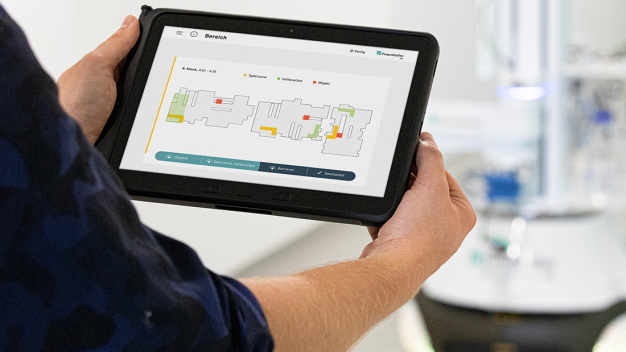



Since October 2020, a multidisciplinary team of researchers at Fraunhofer-Gesellschaft has been working on the Mobile Disinfection (MobDi) project aimed at using robotics technologies to prevent the spread of infection in clinical settings. Led by the Fraunhofer Institute for Manufacturing Engineering and Automation (IPA), the team is developing specialized service robots capable of disinfecting potentially contaminated surfaces and automating the transport of essential items.
It is necessary to train a robot before its first usage in a new operating environment. This means that the user drives the robot around to enable it to automatically register a map of its future working space. The robot also recognizes all the door handles, light switches, and other high-touch surfaces which need to be cleaned, as well as the material they are made of. Based on this information, the robot can plan independently all the necessary cleaning sequences.
Thanks to BIM, which already exists for many buildings, this learning process does not have to be conducted manually anymore. The BIM contains a digital representation of key building components, which can automatically be transferred to the robot before starting its operation.
The MobDi project also deals with the development of a new transportation robot. It will be able to carry various hand carts, such as those typically used in clinics. In comparison with existing products, the new development is characterized by smaller dimensions and a particularly maneuverable undercarriage. It will help staff to reduce walking distances by providing all the materials required to treat the patients directly in front of their rooms. This not only helps to avoid spreading germs but also increases the amount of time staff can spend with the patients and performing actual care tasks. All robots developed in MobDi are designed with the help of ‘hygienic design’ and with self-cleaning methods implemented into the design, thereby preventing the machines themselves from becoming a contamination risk.
Robots can certainly be useful support in the fight against COVID-19. The project shows particular potential in the use of disinfection and transport robots. They can operate continuously and reduce staff contact with vulnerable people such as the sick or – if they were implemented in a care facility – the elderly. A similar potential is seen in robots for telehealth applications: they make it possible to maintain remote contact with family or even doctors without the risk of spreading infection.
1 Comment. Leave new
This is such a wonderful use of technology – but it does rely on the BIM plan being a 100% accurate representation of the floor plan. Organisations interested in this approach should consider using 3D scanning to ensure that the floorplan in their BIM plan represents as-built conditions, rather than the original plan (which may have been changed during construction).